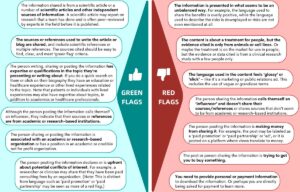Written by Trinity Lowthian and Dawn Richards
With all the information that’s available on social media or generally on the internet, it can be difficult to know what is trustworthy or credible content and what is simply trying to get you to ‘click’ or to buy something. It’s good to question information and where it comes from.
If you are finding that separating facts from fiction is not as clear as it used to be, you’re not alone. In 2023, Statistics Canada found that 43% of Canadians said it was becoming more difficult than it was just 3 years earlier to tell the difference between true and false information (https://www150.statcan.gc.ca/n1/daily-quotidien/231220/dq231220b-eng.htm).
Here we give some guidance to help you decide what information you should view as evidence-based or credible, and what might give you cause for a little more skepticism.
Below we’ve created some criteria to distinguish between ‘red flags’ and ‘green flags’ when sorting through information online that you are reading, watching or listening to. If the content you are reading, watching, or listening to is aligning with statements in the red flag column, this should be taken as potential cause for concern and we suggest that you question the motivation of who’s sharing the information, their credentials, and what they’re presenting to you or even selling you. If the content and source of information is aligning with statements in the green flag column, this may point towards evidence or information being more credible.
Green Flags:
- The information shared is from a scientific article or a number of scientific articles and other independent sources of information. A scientific article may report on research that a team has done and is often peer-reviewed by experts in the field before it is published.
- The sources or references used to write the article or blog are shared, and include scientific references or multiple references. The sources cited should be easy to find, clear, and meet ‘green flag’ criteria.
- The person writing, sharing or posting the information has expertise or qualifications in the topic they’re presenting or writing about. If you do a quick search on them or click on their biography they have an education or healthcare experience or other lived experiences related to the topic. Note that patients or individuals with lived experiences may also have expertise about topics, in addition to academics or healthcare professionals.
- Although the person posting the information calls themself an influencer, they indicate that their sources or references are from academic or research-based institutions.
- The person sharing or posting the information is associated with an academic or research-based organization or has a position in an academic or credible not for profit organization.
- The person posting the information declares or is upfront about potential conflicts of interest. For example, a researcher or clinician may share that they have been paid consulting fees by an organization. (Note: This is distinct from language such as ‘paid promotion’ or ‘paid partnership’ may be seen as more of a red flag.)
Red Flags:
- The information is presented in what seems to be an unbalanced way. For example, the language used to share the benefits is overly positive, while the language used to describe the risks is downplayed or risks are not even mentioned at all.
- The content is about a treatment for people, but the evidence cited is only from animals or cell lines. Or maybe the treatment is on the market for use in people, but the evidence or data cited is from a clinical research study with a few people only.
- The language used in the content feels ‘glossy’ or ‘slick’ – like it’s a marketing or public relations ad. This includes the use of vague or grandiose terms.
- The person sharing the information calls themself an ‘influencer’ and doesn’t share their sources/references or shares sources that don’t seem to be from academic or research-based institutions.
- The person posting the information is making money from sharing it. For example, the post may be labeled as a ‘paid promotion’ or ‘paid partnership’ or ‘ad’, or it is posted on a platform where views translate to money.
- The post or person sharing the information is trying to get you to buy something.
- You need to provide personal or payment information to download the information. Or perhaps you are directly being asked for payment to learn more.

While we can’t directly tell you what is credible and what is not credible information, using the questions above can help you make that decision for yourself. The questions above are meant to help give you some confidence in making that decision and in sifting through sources of information. Taking a pause and questioning information are key tools that can help you navigate information. It might take you a while to get comfortable with questioning information – but that’s a good thing!

